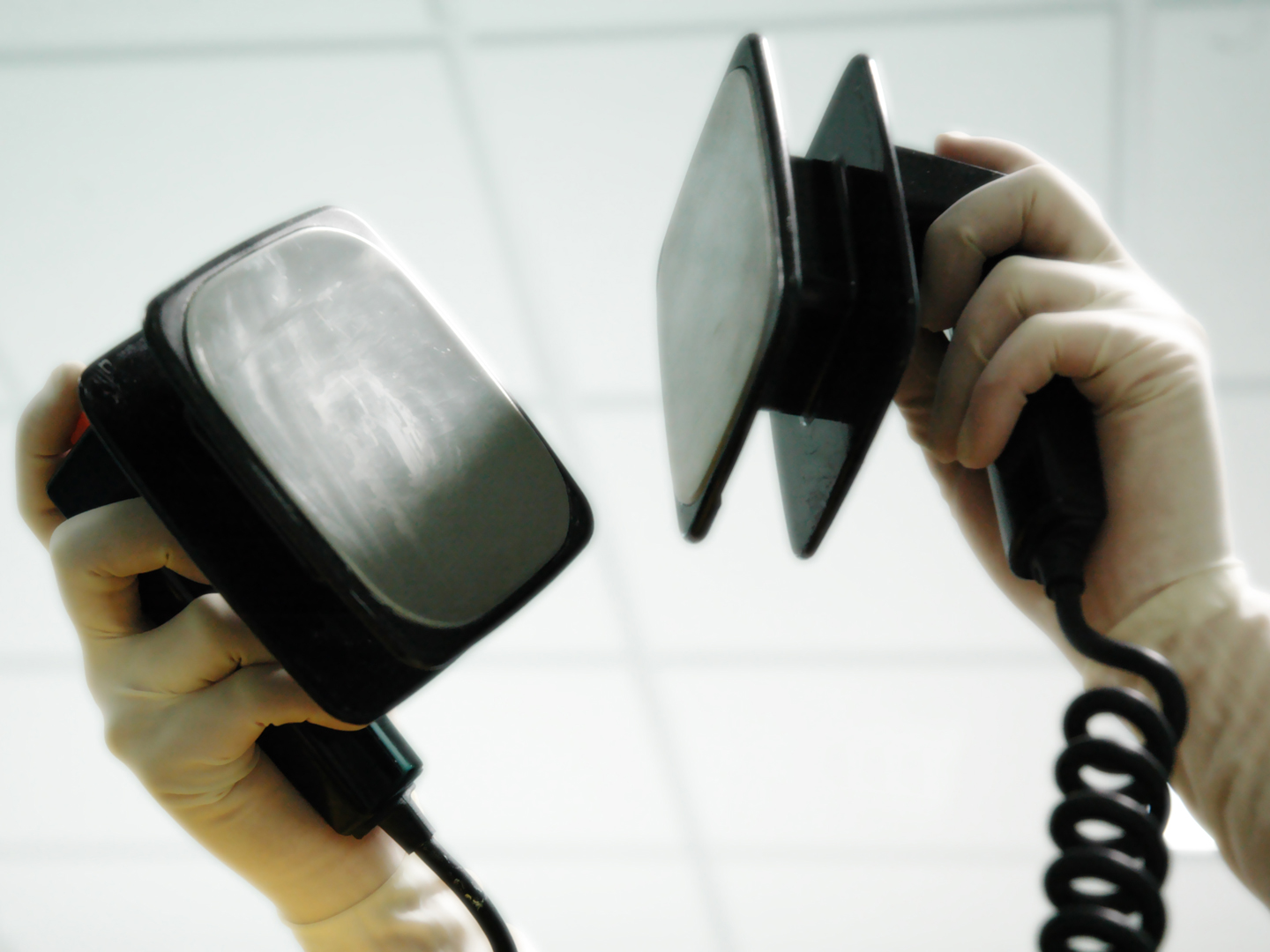Abnormal Heart Rhythm (Bradycardia)

What is abnormal heart rhythm?
There are many kinds of abnormal heart rhythms, which are collectively known as arrhythmias. One of the most common is abnormally slow heartbeats, a condition known as bradycardia. For most people, a normal resting heart rate is considered to be between 60 to 100 beats a minute; anything less than this may be considered bradycardia.
It is important to note that a slow heart rate can sometimes be normal, and even a sign of good physical fitness. Healthy young adults and athletes often have resting heart rates of less than 60 beats per minute; for example, champion bicycle racer Miguel Indurain reportedly had a resting heart rate of 28 beats per minute. This occurs because high-intensity training makes the heart muscle relatively powerful. Blood travels further through arteries and veins with each contraction, making fewer contractions necessary.
But slow heart rates may also indicate heart disease. Some individuals have a slow rate because of a problem within the heart’s electrical conduction system: the heart’s natural pacemaker is not working properly or the electrical pathways of the heart are disrupted.
In severe forms of bradycardia, the heart can beat so slowly that it doesn’t supply enough blood to meet the body’s needs. This can be life-threatening and often requires a pacemaker. A pacemaker is a medical device implanted in the chest that stimulates heart contractions via small electrical impulses.
A pacemaker can keep track of the heartbeat and generate electrical signals similar to that of the heart when it is operating normally, thus causing it to beat appropriately. Ultimately, the purpose of a pacemaker is to maintain heartbeats so that adequate oxygen and nutrients are delivered through the blood to the organs of the body.
What are the symptoms?
Some people with bradycardia have no symptoms, or their symptoms are so mild that they attribute them to the normal process of aging. An inappropriately slow heart rate results in insufficient blood flow to organs and tissues, which can ultimately lead to malfunction and organ failure. The one organ most affected by lack of oxygen and proper nutrients – particularly glucose – is the brain. Poor blood supply to the brain may cause a feeling of dizziness or lightheadedness, confusion and forgetfulness, poor memory and trouble concentrating or changes in consciousness. People can faint if a slow heart rate causes their blood pressure to drop critically.
Inadequate blood supply to muscles may lead to feeling short of breath, with decreased exercise tolerance, increased fatigue, cramping or diffuse muscle pain. Chest discomfort or heart palpitations – feeling one’s heart pounding or fluttering – can also be a sign of bradycardia.
You can determine how fast your heart is beating by taking your pulse. Feel your heartbeat at the base of your neck (just under the chin or on the underside of the wrist, below the base of the thumb). Count the number of beats in a minute. If your heartbeat is slow (less than 60 – about one beat per second, especially if you are not athletic) or uneven, talk to your doctor.
What are the causes?
The heart has its own electrical conduction system that regulates how fast and how hard it pumps. Electrical signals begin at the sinoatrial (SA) node – the heart’s natural pacemaker – located on the wall of the right atrium. Electrical signals from the SA node travel along the walls of the atria, causing atrial muscles to contract and pump blood into the lower chambers of the heart. These same electrical signals then travel to the AV node, a small area between the atria and ventricles that serves as an electrical relay station. From the AV node, these electrical signals travel along special conduction tissues to reach the walls of the ventricles, causing the ventricles to pump.
Bradycardia can result from diseases affecting the SA node, the conduction tissues, and the AV node. Sick sinus syndrome occurs when the SA node cannot generate signals frequently enough to maintain an adequate heart rate. Heart blocks of various degrees and heart failure can occur when cellular damage (due to high blood pressure and heart attacks) or age-related degeneration of the conduction system causes an impaired transmission of signals down through the heart muscle (myocardium). Certain medications can also cause bradycardia or worsen already existing disease. These include calcium channel blockers like nifedipine (Procardia) and verapamil (Calan) used for blood pressure regulation; along with digoxin (Lanoxin), used for arrythmias and to treat heart failure; and beta-blockers, such as atenolol (Tenormin) and propanolol (Inderal), used for hypertension and following myocardial infarction to protect surviving heart tissue.
The most common cause of bradycardia is degeneration of the conduction system due to aging. Thus, people are more likely to need a pacemaker as they get older, both as part of the aging process and because older patients tend to have additional medical problems that can cause slow heartbeats.
What is the conventional treatment?
If the patient has no symptoms, medical treatment may not be warranted. In some cases, the bradycardia is caused by medication, which if it can be safely stopped may cause the heart rate to normalize. However, because bradycardia is usually related to problems with cardiac conduction, the only method currently available to consistently increase heart rate is the use of a pacemaker.
Temporary pacemakers are usually used first, especially if the abnormally slow heart rate is thought to be a reversible condition that may be corrected. Temporary pacemakers are easily disconnected if the heart rate returns to normal.
Permanent pacemakers become necessary when bradycardia is believed to be a chronic or irreversible condition. Even though the overall heart rate may not be slow, pacemakers may also be used to treat fainting spells (syncope), congestive heart failure, hypertrophic cardiomyopathy, and other conditions where a controlled heartrate is desireable. It is implanted just under the skin of the chest wall in a relatively simple outpatient surgical procedure.
The pacemaker has two parts: the pulse generator and the leads. The pulse generator is implanted under the skin; it houses the battery and a tiny computer that sets the pacing of the heart and keeps track of the pulse. The leads are wires connected to the pulse generator that are threaded through the veins into the heart and implanted into the heart muscle. They send impulses from the pulse generator to the heart muscle, as well as sensing the heart’s electrical activity. When the heart beats normally, the pacemaker does nothing; however, if the heart stops beating or slows down, the pacemaker can take over at the selected rate. Typically, most implantable pacemakers have a battery that can last 10 to 15 years. The leads are relatively resistant to damage and pose little risk for infection or damage to heart tissue.
There are different types of pacemakers: single-chamber pacemakers use one lead in the upper chambers (atria) or lower chambers (ventricles) of the heart; whereas a dual-chamber pacemaker uses one lead in the atria and one lead in the ventricles. A biventricular pacemaker uses three leads: one placed in the right atrium, one placed in the right ventricle, and one placed in the left ventricle. Your doctor will decide what type of pacemaker you need based on your heart condition.
Remember, most household electrical appliances do not interfere with pacemakers; however, it is important to know which devices can cause interference with pacemaker signals. MRI machines and all magnetic devices that generate a strong magnetic field should be avoided. Cell phones can interfere with older style pacemakers and should be carried and used on the side of the body opposite to the side in which the pacemaker is implanted. Theft detector gates in stores can be a problem if individuals with pacemakers stand at or near them for long periods of time, but are probably not a problem if one walks quickly through them. Metal detectors at airports as well as handheld security wands can cause interference since they also generate magnetic fields. Individuals with pacemakers should present their ID card to security officers and walk around the gates. In pacemakers with older circuitry, high-powered electrical tools and running car engines can cause disturbances in electrical activity; although most patients can drive a car, they should not lean over a running engine. Patients should check with their physicians if unsure about operating machinery or driving.
What therapies does Dr. Weil recommend for abnormal heart rhythm?
Nutritionally, Dr. Weil recommends an anti-inflammatory diet to anyone with cardiovascular disease, including daily Omega 3 fatty acid supplements, and eating two to three servings of fish – particularly oily species such as salmon or sardines – per week.
In addition, follow your doctor’s recommendations for heart health – quit smoking, watch your diet, and begin getting regular exercise. Control risk factors by working to address high blood pressure, diabetes and atherosclerosis, and reduce stress (the hormones released by the body in response to stress, anxiety and depression make the heart work harder). Practice relaxation techniques, volunteer, and seek positive social interactions. The Relaxing Breath can improve the oxygenation of blood and take workload off the heart.
Dr. Weil also recommends the following supplements if you are coping with heart-related issues:
- Coenzyme Q10(CoQ10). CoQ10 is a powerful antioxidant that has been shown to be beneficial for heart health by improving the utilization of oxygen at the cellular level. This nutrient is very important for the heart cells of patients with heart failure or tissue damage in the heart. CoQ10 may also help lower blood pressure.
- L-Carnitine. This amino acid is essential for energy metabolism of the heart muscle.
- Cordyceps. A medicinal mushroom that helps boost aerobic capacity and can improve the efficiency of the lungs and heart.
- Hawthorn. This herb, which should only be used under a doctor’s supervision, may increase heart-muscle strength and also act as a mild diuretic.
- D-Ribose. This naturally occurring five-carbon sugar has proven beneficial for maintaining adequate energy reserves in compromised heart tissue, and is especially recommended for those with congestive heart failure.
Be sure to discuss the use of any supplement with your doctor. Your prescription drug dosages may need to be adjusted as these other measures take effect.









